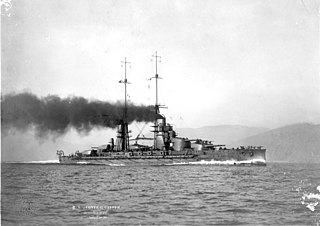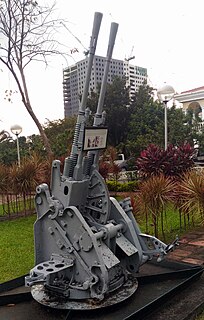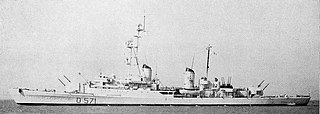Description
The Menon system fired a 305-millimeter (12 in) projectile weighing 160 kilograms (350 lb) to a maximum range of 1,500 meters (4,900 ft). [1] It fired 21 rounds in 70 seconds that covered an area of about 90 by 180 square yards (75 by 151 m2). [2]
The initial version consisted of a three-barrel mortar in a rotating, enclosed mounting that was usually positioned forward of the superstructure, but aft of the gun mounts. [1] This was replaced by the K 113 weapon with a single 4.6-meter (15 ft 1 in) barrel in the same type of mounting, albeit with a fixed elevation of 45°. By varying the gas vent valves in the three powder chambers, the weapon had a range between 400 and 900 meters (440 and 980 yd). The K 113 fired a seven-round pattern, loaded automatically from a seven-round cylinder. [2]
Short-barreled models were also used, although details are lacking.

A mortar is usually a simple, lightweight, man-portable, muzzle-loaded weapon, consisting of a smooth-bore metal tube fixed to a base plate with a lightweight bipod mount and a sight. They launch explosive shells in high-arcing ballistic trajectories. Mortars are typically used as indirect fire weapons for close fire support with a variety of ammunition.

The Delaware-class battleships of the United States Navy were the second class of American dreadnoughts. With this class, the 16,000 long tons (16,257 t) limit imposed on capital ships by the United States Congress was waived, which allowed designers at the Navy's Bureau of Construction and Repair to correct what they considered flaws in the preceding South Carolina class and produce ships not only more powerful but also more effective and rounded overall. Launched in 1909, these ships became the first in US naval history to exceed 20,000 long tons (20,321 t).

The AK-230 is a Soviet fully automatic naval twin 30 mm gun. Its primary function is anti-aircraft. It is mounted in an enclosed automatic turret and directed by radar. AK-230 is widely used, mounted on big warships as well as small craft. About 1450 guns were produced in the USSR, and about 300 were produced in China as the Type 69. It was succeeded by the more powerful AK-630 from the mid-to-late 1970s.

The L and M class was a class of sixteen destroyers which served in the British Royal Navy during World War II. The ships of the class were launched between 1939 and 1942.

Squid was a British World War II ship-mounted anti-submarine weapon. It consisted of a three-barrelled mortar which launched depth charges. It replaced the Hedgehog system, and was in turn replaced by the Limbo system.

The Conte di Cavour–class battleships were a group of three dreadnoughts built for the Royal Italian Navy in the 1910s. The ships were completed during World War I, but none saw action before the end of hostilities. Leonardo da Vinci was sunk by a magazine explosion in 1916 and sold for scrap in 1923. The two surviving ships, Conte di Cavour and Giulio Cesare, supported operations during the Corfu Incident in 1923. They were extensively reconstructed between 1933 and 1937 with more powerful guns, additional armor and considerably more speed than before.

The M242 Bushmaster chain gun is a 25 mm (25×137mm) single-barrel chain-driven autocannon. It is used extensively by the U.S. military, such as in the Bradley fighting vehicle, as well as by other NATO members and some other nations in ground combat vehicles and various watercraft. Hughes Helicopters in Culver City, California was the original designer and manufacturer. McDonnell Douglas Helicopters acquired Hughes Helicopters in 1985, and merged into Boeing Corporation in 1997. In 2002, it was sold again to Alliant Techsystems, which merged with Orbital Sciences Corporation in 2015 to form Orbital Science ATK and was, in turn, bought out by Northrop Grumman in 2018. As of 2019, Northrop Grumman Innovation Systems produces the gun.

The Type 96 25 mm gun was an automatic cannon used by the Imperial Japanese Navy during World War II. A locally-built variant of the French Hotchkiss 25 mm anti-aircraft gun, it was designed as a dual-purpose weapon for use against armored vehicles and aircraft, but was primarily used as an anti-aircraft gun in fixed mounts with one to three guns.

The Soltam K6 is a 120 mm mortar that was developed by Soltam Systems of Israel. It is the long-range version of the Soltam K5 and has replaced older systems, such as the 107-millimetre (4.2 in) M30, in several armies including the United States Army. It is much lighter than the M30, has a greater range, and can sustain a rate of fire of four rounds per minute, while the M30 could sustain only three.

Dante Alighieri was the first dreadnought battleship built for the Regia Marina and was completed in 1913. The ship served as a flagship during World War I, but saw very little action other than the Second Battle of Durazzo in 1918 during which she did not engage enemy forces. She never fired her guns in anger during her career. Dante Alighieri was refitted in 1923, stricken from the Navy List five years later and subsequently sold for scrap.

The Lyon class was a set of battleships planned for the French Navy in 1913, with construction scheduled to begin in 1915. The class was to have comprised four ships, named Lyon, Lille, Duquesne, and Tourville. The first two were named for cities in France, and the latter pair honored the French admirals Abraham Duquesne and Anne Hilarion de Tourville. The Lyon class' design was an improvement on the previous Normandie class, utilizing a fourth quadruple-gun turret to mount a total of sixteen 34 cm (13.4 in) guns. Construction on the Lyons was cancelled due to the August 1914 outbreak of World War I, before any of the ships were laid down.

The Restigouche-class destroyer was a class of seven destroyer escorts that served the Royal Canadian Navy and later the Canadian Forces from the late-1950s to the late-1990s. All seven vessels in the class were named after rivers in Canada.
The German Imperial Navy created a series of fleet cruiser designs—designated Flottenkreuzer—in 1916 to follow the Cöln-class cruisers ordered in 1915. They were initially intended to favor high speed for reconnaissance over the heavier gun armament of the Cöln class, though by the final iterations, they were as powerful as the earlier class. The design staff ultimately drew up five different designs: FK 1, FK 1a, FK 2, FK 3, and FK 4. The proposals ranged in size from 3,000 metric tons to 7,500 t designed displacement and were armed with a main battery of between five and eight 15 cm (5.9 in) guns. Each proposed design grew in size over the preceding draft, as the weaponry and propulsion systems were increased. None of the designs were built, owing to shifting construction priorities in the German Navy in the last year of World War I.

The 41 cm/45 3rd Year Type naval gun was a 41-centimeter (16.1 in) breech-loading naval gun designed during World War I for the Imperial Japanese Navy. It served as the primary armament in the Nagato-class dreadnoughts completed after the end of the war and in coast defense mountings. Two turrets and their guns were salvaged during the 1970s from the wreck of the Japanese battleship Mutsu and are on display in Japan.

The Italian destroyer Audace was originally ordered by Japan from Yarrow Shipbuilders in Scotland under the name of Kawakaze, but was transferred to Italy in 1916 while still under construction. She served as the command ship for the radio-controlled target ship San Marco in 1937–1940 and then was rearmed for convoy escort and patrolling duties when World War II began. Audace was captured by the Germans in 1943 and used by them as a minelayer and escort ship in the Adriatic Sea until she was sunk by a pair of British destroyers in late 1944.

The Centauro class consisted of four frigates built for the Italian Navy during the 1950s. They entered service in 1957, with the last one being stricken in 1985.

Centauro was the lead ship of the her class of four frigates built for the Italian Navy in the 1950s.

Canopo was one of four Centauro-class frigates built for the Italian Navy in the 1950s.

Castore was one of four Centauro-class frigates built for the Italian Navy in the 1950s.

Cigno was one of four Centauro-class frigates built for the Italian Navy in the 1950s.


















